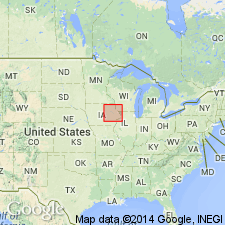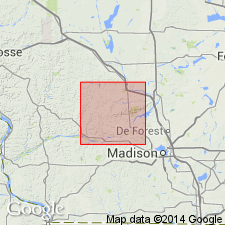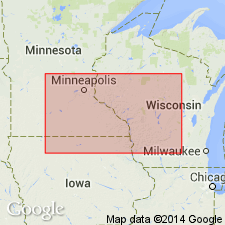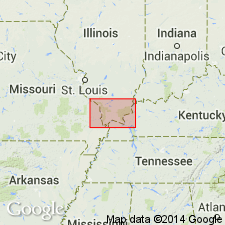
- Usage in publication:
-
- Oneota limestone
- Modifications:
-
- Original reference

- Usage in publication:
-
- Oneota dolomite*
- Modifications:
-
- Revised
- AAPG geologic province:
-
- Sioux uplift
Summary:
Oneota dolomite of Prairie du Chien group. Age is Early Ordovician (Beekmantown). Recognized in Iowa, southern Minnesota and Wisconsin, and northwestern Illinois.
For many years the Iowa Geol. Survey used Oneota limestone to include the Shakopee at top. In 1906, however, S. Calvin recognized in Iowa the 3 subdivisions then recognized in Minnesota and Wisconsin, i.e., Shakopee limestone, New Richmond sandstone, and Oneota limestone, and since that time these names have been generally employed in Iowa also. Ulrich assigns the Oneota to his Ozarkian system, in view of which the USGS formerly classified it as "Cambrian or Ordovician." It is lower formation of Prairie du Chien group, all of which Trowbridge and Atwater would include in Lower Ordovician. (See under Prairie du Chien group.) The USGS at present [ca. 1936] classifies Oneota dolomite as Lower Ordovician (Beekmantown).
See also under Shakopee dolomite and New Richmond sandstone.
In 1925 (Jour. Geol., v. 33, p. 706-713) C.R. Stauffer published a section of Oneota dolomite and Jordan sandstone in Minnesota River Bluff and at adjacent quarries at Kasota, Minnesota, in which he transferred to Oneota dolomite 6.5 feet of fossiliferous sandstone which he stated had "always been included in Jordan sandstone, but which was probably reworked after deposition and should be included in the Oneota, where its fauna seemed to belong." L.H. Powell, 1935 (St. Paul Inst., Sci. Mus., Sci. Bull. 1), introduced Kasota sandstone for this 6.5-foot bed, and named the overlying 6 inches to 3 feet of "siltstone," as he called it, Blue Earth siltstone. Powell excluded both of these thin beds from the Oneota and treated them as distinct formations, stating that they occur only in region from Ottawa, Minnesota, to Mankato. The Rpt. 9th Field Conf. Kansas Geol. Soc., 1935, fig. 1, shows "Blue Earth and Kasota, local formations in Minnesota" as = basal part of Oneota dolomite, which is shown as underlain by Madison sandstone.
Source: US geologic names lexicon (USGS Bull. 896, p. 1549-1550).

- Usage in publication:
-
- Oneota Formation
- Modifications:
-
- Revised
- Dominant lithology:
-
- Dolomite
- Chert
- AAPG geologic province:
-
- Wisconsin arch
Summary:
Coon Valley, originally defined as upper member of Jordan Sandstone, here included at base of Oneota Formation. In Sauk Co., WI, Oneota generally consists of approximately 25 m of hard dolomite. Grain sizes vary from very fine sand to medium sand. Dolomite generally ranges from very pale brown to light brownish gray when fresh. White chert nodules and beds occur throughout. Quartz sand, oolitic dolomite, algal structures, and chert near base constitute Coon Valley Member. Elsewhere these sandy beds have been designated Hickory Ridge and Stockton Hill Members. Oneota underlies Rountree Formation (new name) or St. Peter Formation.
Source: GNU records (USGS DDS-6; Reston GNULEX).

- Usage in publication:
-
- Oneota Dolomite
- Modifications:
-
- Revised
- AAPG geologic province:
-
- Upper Mississippi embayment
Summary:
Rather than being in conformable contact (as is commonly assumed), Early Ordovician Oneota Dolomite is here interpreted as unconformably overlying the Late Cambrian (Croixan) Jordan Sandstone. The Oneota remains transgressive, in contrast to new evidence that the Jordan is here determined to be entirely marine and regressive. The fact that the unconformity is regional has important implications for boundary placement in the entire Upper Mississippi Valley. Report includes measured sections and cross section.
Source: GNU records (USGS DDS-6; Reston GNULEX).

- Usage in publication:
-
- Oneota Dolomite*
- Modifications:
-
- Areal extent
- AAPG geologic province:
-
- Illinois basin
Summary:
Oneota Dolomite found in subsurface in IL and KY. Assigned to Knox Group. Correlates with Gasconade Dolomite in MO. Gunter Sandstone Member occurs sporadically in southern part of Illinois basin.
Source: GNU records (USGS DDS-6; Reston GNULEX).
For more information, please contact Nancy Stamm, Geologic Names Committee Secretary.
Asterisk (*) indicates published by U.S. Geological Survey authors.
"No current usage" (†) implies that a name has been abandoned or has fallen into disuse. Former usage and, if known, replacement name given in parentheses ( ).
Slash (/) indicates name conflicts with nomenclatural guidelines (CSN, 1933; ACSN, 1961, 1970; NACSN, 1983, 2005, 2021). May be explained within brackets ([ ]).

